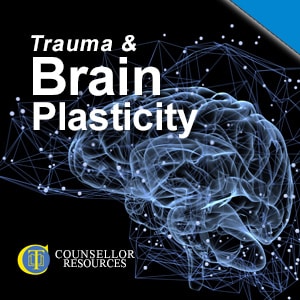Brain Plasticity and Trauma
Fourth Force in Psychology
The first force in psychology was psychoanalysis, brought to us by Sigmund Freud.
Then, in the 1940s and 1950s, came the second force, behaviourism (courtesy of people like Skinner and Watson).
Later, in the 1960s, Rogers and Maslow introduced humanism, the third force in psychology.
The fourth force in psychology is now plasticity. This represents a common ground for psychotherapists and neurologists, bringing together the structure/working of the brain with emotions.

Watch this Lecture + Access Hundreds of Hours of CPD
Certified CPD for Qualified Counsellors
- Hundreds of hours of on-demand CPD lectures to help you stay current with your CPD ethical requirements
- Support, and be supported, by thousands of other counsellors as a member of the exclusive online community.
- Access your learning anytime you want ... anywhere you choose ... using any device type — desktop or mobile.

The Triune Brain
In the 1950s, neurologist Paul MacLean proposed an idea known as the triune brain, describing the human skull as holding not one brain but three. Each part represents a distinct evolutionary function.
This represented the beginning of looking at the brain in terms of function rather than simply structure.
1. The Cerebellum
The first part of the brain is called the cerebellum or archipallium; it is sometimes known as the reptilian brain, as reptiles all have this type of brain too.
This is our automatic pilot, taking care of our movement, respiration and temperature.
It is a very primitive device, and maintains everything we can’t control. For example, if we hold our breath long enough, we eventually have to breathe.
When a trauma occurs, the cerebellum is an auto-pilot, triggering the survival mechanism. When the cerebellum is activated, we have very little control over it.
2. The Limbic System
Second, we have the limbic system or paleomammalian brain (showing its mammalian links: cats and dogs have this type of brain). This part of the brain controls memories, habits, decisions, and emotions.
If somebody upsets us, it’s the limbic system here that activates, perhaps making us feel sad or angry.
The amygdala (at the front of our brains in the limbic system) gets its name from the Greek for 'almond', because it’s the shape of an almond. It is the fire alarm of the brain, but can’t tell the difference between a life-threatening house fire and the toast burning!
The hippocampus also lies within the limbic system, and is our video memory.
In times of stress, the amygdala activates the memories in the hippocampus – thus causing flashbacks in post-traumatic stress disorder (PTSD).
3. The Neocortex
Finally, there is the neocortex or neopallium. This is what makes us human; it’s the thinking part of the brain.
This part of the brain comes into play after the initial emotional response to rationalise and so make sense of what has happened.
It controls language, abstract thought and reasoning. Thus, it can serve as a ‘brake’, stopping us from reacting in line with the limbic system, which could get us into trouble.
Child Development
In a new baby, there is no regulation of emotions: they just haven’t got that part of the brain wired up yet.
They simply work on the limbic system, but the hippocampus doesn’t develop until about age three or four years.
This means that young children who are abused may have only a snapshot of what’s happened.
The amygdala, meanwhile, is functional immediately, meaning that a baby will be startled by a loud noise.
The Role of Hormones
Researchers – for example, Stephen Porges – have concluded that in times of stress, we produce a hormone called cortisol.
Cortisol comes from the kidneys and travels through the polyvagal system, a conduit that runs through the body, ending in the brain.
Its role is to trigger the survival instincts of the limbic system. If a lot of cortisol is produced, the amygdala and hippocampus shut down, leaving the limbic system to go into survival mode.
At this point, the body also activates adrenaline. This enables us to be physically stronger for a time, to repair our wounds and to limit the amount of pain we feel.
Often, clients who have been in situations where they believed their lives were at risk may ask questions like: ‘Why didn’t I fight him off?’, ‘Why didn’t I run away from her?’ or ‘Why did I let them do what they did?’ It’s important to tell them them: ‘It’s not your fault’. Explaining how the human brain works in this situation – is really helpful here, enabling clients to understand why they acted as they did. This can bring significant closure to clients.
Free Handout Download
Brain Plasticity and Trauma
The Five Fs
The survival system is very effective when a threat is real, boosting our chance of staying alive.
However, in PTSD, it is triggered needlessly. For example, a military veteran may smell diesel and go into this mode, because once when they smelled that, they were being shot at.
‘Fight or flight’ are well known modes when the survival system kicks in, but in fact there are also three more possible reactions: freeze, friends or flop.
Which we select to follow depends on a split-second decision on which gives us the best chance of survival:
- Fight is a dangerous strategy because it consumes energy and requires superior ability in some form.
- Flight too is risky as it again uses energy and resources, plus we might not be able to run as fast as our assailant.
- Freeze comes from the idea that some animals won’t attack or kill another creature that is already dead, because they don’t know that it’s fresh to eat.
- Friends (i.e. looking for support in a stressful situation) is a strategy we may see in children who are being told off, when they appear to be laughing at you, or in someone who looks around at others sadly in an effort to communicate that something is wrong.
- Flop occurs when the amygdala and the hippocampus become overloaded with cortisol, leading to us either playing dead or splitting off into a dissociative state.
The Brain in Trauma
When extreme stress strikes, the cortex is not available.
Often, clients who have been in situations where they believed their lives were at risk may ask questions like: ‘Why didn’t I fight him off?’, ‘Why didn’t I run away from her?’ or ‘Why did I let them do what they did?’
It’s important to tell them them: ‘It’s not your fault’.
Psycho-education – i.e. explaining how the human brain works in this situation – is really helpful here, enabling clients to understand why they acted as they did.
Being able to explain with confidence to them that their body was acting as it’s programmed to do can bring significant closure to clients.
Abuse and Neglect in Children
In a child who is not cared for properly, there are visible differences in the brain, leading to:
- splitting (disassociation)
- fragmenting (a psychotic state)
- no self-regulation
- loss of trust
These in turn lead to anxiety, depression, yearning, rage and self-soothing (e.g. through drug abuse).
In a child, in times of stress, the brain gets flooded with cortisol, which shuts down the amygdala and the hippocampus. It’s a form of self-soothing and a protection mechanism.
In other words, it switches off the video feed so they don’t have to remember what happened.
The brain can repair itself by developing new neural pathways. Thus, even someone who has been very badly damaged and abused can – given time – develop a healthier attachment style, especially when supported by the right therapy and self-care.
Brain Plasticity
This describes the ability to form new neural pathways. This is how we learn new things.
Similarly, the brain can repair itself by developing new neural pathways.
Thus, even someone who has been very badly damaged and abused can – given time – develop a healthier attachment style, especially when supported by the right therapy and self-care.
Working with Attachment and Self-Regulation in Clients
Traumatic events can change our attachment style, or catapult us back to a previous unhealthy attachment style that we had since changed.
Do be consistent with clients, stay in their frame of reference, let them know what impact they’re having, and be careful about overpraising them (as this can trigger an avoidant attachment style, and may be very alien to them).
It can be helpful to remind the client that their feelings are from the there-and-then not the here-and-now, reminding them that they are now relatively safe in the world.
Do be thoughtful, understanding that emotional functioning may be difficult, commenting on positive changes you notice, and being aware that they could temporarily relapse to their previous way of being.
Last but not least, If you’re going to work with clients who have attachment issues or a difficult past, you really have to know your own attachment style. Personal therapy, supervision, reflection and reading/research are invaluable here.
Free Handout Download
Brain Plasticity and Trauma